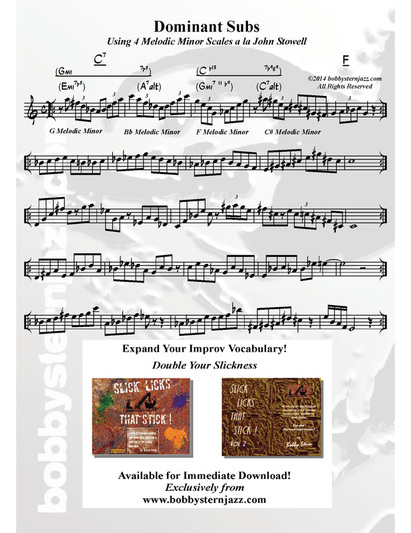 John Stowell
John Stowell Hey, I hadn't even heard of Master Guitarist & Educator, John Stowell until a few months ago, when my long time buddy, Prof. Dave King of the University of Music & Performing Arts in Mannheim, Germany (see post from 5/29/2013), took part in one of John's master classes which was given at the school and sent me some video links.
Needless to say, I was intrigued by Stowell's harmonic and scalar concepts; especially his ideas of mixing and integrating modes of Melodic Minor with modes of Major (e.g. C Dorian with Bb Melodic Minor), not necessarily a measure at a time, but fusing them together as one scale.

So, needless to say, I found and ordered the book, which I received a few days ago. The thing about the small book, though, is the enclosed DVD.
What has intrigued me the most, is John's concept of mixing 4 different Melodic Minor scales (or keys) to substitute for a dominant (V7) resolving to a tonic (I) Major, minor or dominant chord.
Specifically, he mentions (over a C7, in order of least to most tensions) the Melodic Minor scale:
A Perfect 5th above (or P4th below) - G Melodic Minor (#11) - C Lydian Dominant
A Perfect 4th above (or P5th below) - F Melodic Minor (b13) - C Mixolydian b13
A whole step below - Bb Melodic Minor (b9, #9) -
C Dorian b2
A half step above - C# Melodic Minor (b9, #9, #11, b13) -
C Altered Scale
Those of you who have followed my posts here and have purchased my books, know that I've been sharing exercises dealing with 2 Melodic Minor scales per ii-V7
(eg. in C: D-7b5 = F Melodic Minor & G7 = Ab Melodic Minor) and their derivative pentatonics (b3 & b6).
The idea of doubling that number of possibilities over a single dominant chord, and mixing them up at regular or irregular intervals, gets my blood pumping.
However, I first found it necessary to translate this new way (to me) of looking at this concept in a way that I that made the most sense to me.
The downloadable pdf below contains 5 examples, using the four Melodic Minor scales mentioned above, as a sub for C7 resolving to some kind of F.
The 3 lines of chord symbols above the notation refer to the expression of ii-V7s resolving to F on three levels, with the order of Melodic Minor keys being G MM, Bb MM, F MM & C# MM (I switched the order of Bb & F MM from John's originlal list. The reason is explained below):
Line 1 - All 4 Melodic Minor scales as a sub for (V7) C7, added tensions listed.
Line 2 - The first 2 Melodic Minor scales as a ii7b5 (G-7b5) and the following 2 as V7 (C7alt).
Line 3 - 4 Melodic Minor scales, each a bar apiece, creating two sets of ii-V7's, E-7b5, A7alt (ii7b5, V7 in D) & G-7, C7alt (ii7, V7 in C).
The reason I switched the order of Bb & F MM from the original is that Bb MM is normally seen (by me, anyway) as A7alt (A altered scale) which could resolve to D-7b5 or mode vi (Locrian #2) of F Melodic Minor. In this case however, F MM generates a G-7 with a b9 (Dorian b2) leading to a C7alt (VII mode of C# MM), completing the ii-V7 in F.
It's really a great thing when some new info comes along and forces one to view things from a different perspective. That's what growth is all about.
Is that the sound of ice cracking?
Thank you, John!
Stay Tuned!

 RSS Feed
RSS Feed









